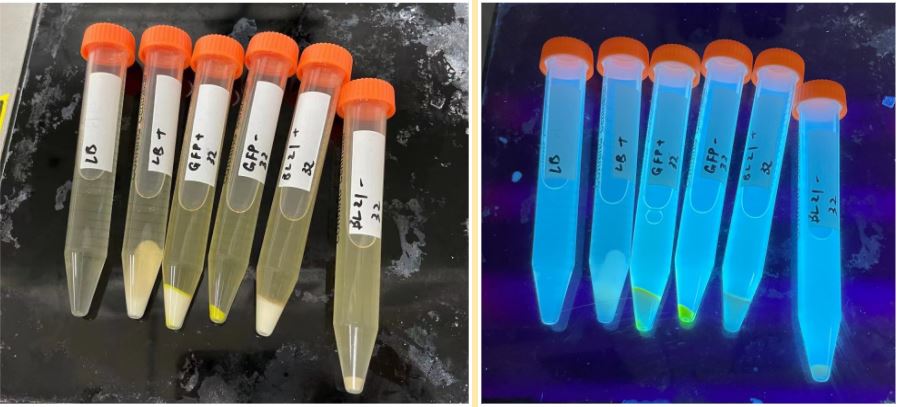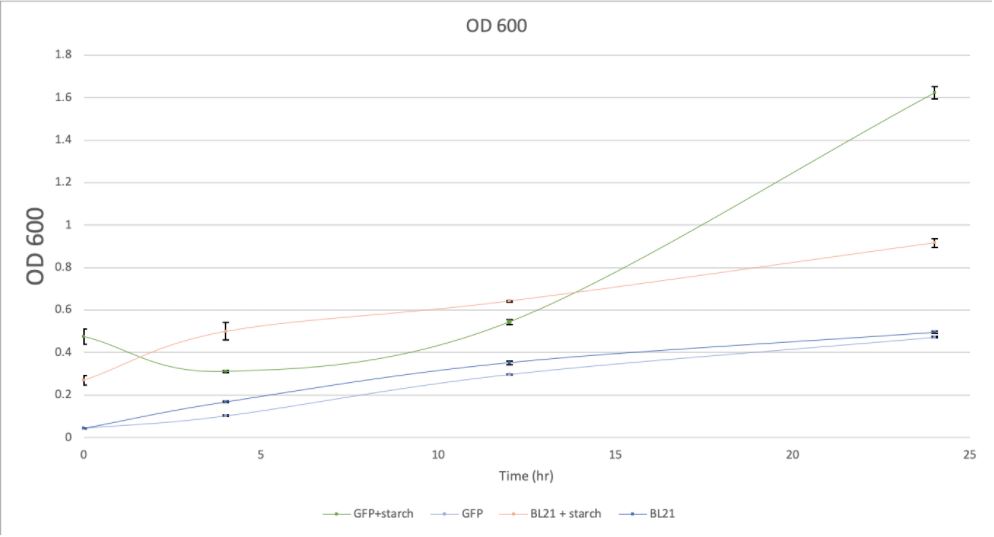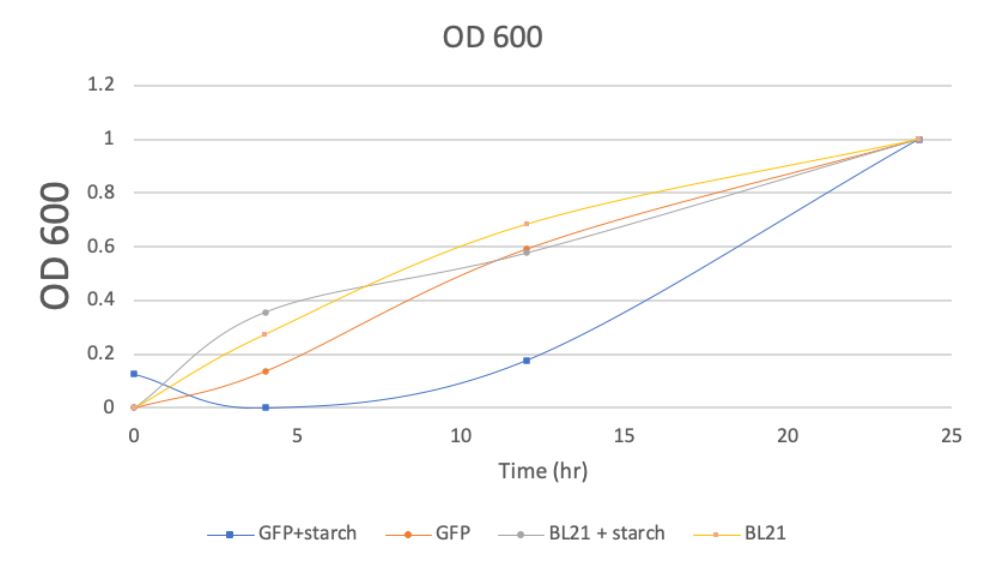Part:BBa_J364000
Test Device 1 for the iGEM InterLab Study
This is a GFP expressing constitutive device for the 2017 iGEM InterLab study. It is called Test Device 1 for the study for easy reference.
This device is stored in pSB1C3 for the InterLab and is fully BioBrick compatible.
Sequence and Features
- 10COMPATIBLE WITH RFC[10]
- 12INCOMPATIBLE WITH RFC[12]Illegal NheI site found at 7
Illegal NheI site found at 30 - 21COMPATIBLE WITH RFC[21]
- 23COMPATIBLE WITH RFC[23]
- 25COMPATIBLE WITH RFC[25]
- 1000INCOMPATIBLE WITH RFC[1000]Illegal BsaI.rc site found at 705
Team NAWI_Graz 2019: GFP dynamics of transformed Escherichia coli strains in LB broth
Background
In Team NAWI_Graz 2019, we found that in normal growth/incubation condition (37oC, LB media + chloramphenicol)
BBa_J364000-transformed Escherichia coli BL21 cells had the highest GFP expression in comparison to BL21 Star and Top 10 strains. Values were consistently higher for BL21 strain over the entire 44-hours measuring period.

We used three different strains of transformed E. coli (Top10,BL21 and BL21 Star) for this study. Transformed strains were incubated in 15 mL LB broth 37 oC overnight. Next day they were used to inoculate a 50 mL LB to OD600=0.1. The cultures were then incubated at 37 oC, 140 rpm and samples were taken every 4 hours for 2 days to determine the green fluorescence protein (GFP) fluorescence intensity at 510 nm.
Result and Findings
- There are significant differences of GFP expression in different strains of E. coli (Top10, BL21, BL21 Star)
- Cultures turned light green under white light after around 14-18 hours of incubation time.







Improvement
- Group: iGEM Team UESTC-China 2019
- Author: Qiuyun Huang, Zixin Wang
This year, we improved this reporter device (BBa_J364000) into a surface display system (BBa_K3034007) (Fig. 1) by fusing GFP with INPNC (BBa_K523008). The improved system can anchor the downstream protein of INPNC to the surface of bacteria, while the GFP is used as the reporter gene. So, other teams who have the need of surface display can insert their target gene into this system.

Ice nucleation protein (INP) is a secretory outer membrane protein from Pseudomomas syringae, P.flurorescens and several other Gram-negative bacteria. INP can anchor one or more "passenger proteins" to the outer membrane of bacteria. The fixation of exogenous proteins on the bacteria surface through INPNC can not only greatly improve the efficiency of enzymatic reaction, but also avoid the degradation of exogenous proteins by intracellular enzymes of host cells[1].
Besides, we added a segment of linker between INPNC and GFP to ensure that two adjacent domains do not sterically interfere with one another. In our experiments, without linker, GFP could not be properly expressed.
Quantitative detection of fluorescence
First, we cultured the bacteria overnight and adjusted them to the same OD600. We ultrasonic broke, centrifuged and respectively resuspend precipitation to measure the fluorescence intensity of GFP in E.coli DH5α carrying BBa_J364000 and E.coli DH5α carrying BBa_K3034007 (Fig. 2).

The results showed that both precipitation and supernatant contained relatively strong GFP. Moreover, the distribution of GFP in E.coli DH5α carrying BBa_K3034007 was not significantly different from that in E.coli DH5α carrying BBa_J364000. There are some differences with our expectation, after analysis, it may be caused by incomplete ultrasonic broken of bacteria.
Since the E.coli DH5α carrying BBa_K3034007 expressed GFP, this indirectly indicated that INPNC was successfully expressed. However, the content of GFP in the E.coli DH5α precipitate (cell membrane) carrying BBa_K3034007 was not significantly higher than the E.coli DH5α carrying BBa_J364000. We hypothesized that INPNC was expressed but the efficiency was not so high.
Microscopic observation
Next, we used fluorescence microscopy to see if the INPNC worked. E.coli DH5α carrying BBa_J364000 (GFP) was rod-shaped and the fluorescence was equably distributed in E.coli (Fig. 3a). The fluorescence of E.coli DH5α carrying BBa_K3034007 (INPNC+GFP) was observed to be dotted and dispersed on the surface of E.coli (Fig. 3b,3c). The results proved that GFP has apparently been anchored to the surface of the E.coli and INPNC was working.
In addition, we also noticed that E.coli DH5α carrying BBa_K3034007 (INPNC+GFP) had fluorescence aggregation on one side of the E.coli surface (Fig. 3c). The result is consistant with fact that we found in the literature[2] that the INPNC forms aggregates in the cell membrane.Thus, we are more clear that we have achieved our improvement.

Conclusion
- We improved this part. GFP is an intracellular reporter gene, and we achieved the expression of GFP on the surface of E.coli.
- Based on the current results, there is space for further improvement in the efficiency of system expression, and the key point is that the activity of INPNC needs to be improved.
- Other teams who have the need of surface display can insert their target gene into this system. For example, the system can be applied to whole-cell biocatalysts, heavy metal contamination adsorption, antigen and antibody display, etc[1].
Team PuiChing Macau 2021: E.coli growth in food waste analysis
We would like to analyze the growth of E.coli via Green Fluorescent Protein (GFP). To examine the growth of E.coli in food waste, the Optical Density of E.coli is commonly used. Yet, in the presence of food waste (starch from rice as an example here), it is difficult to measure the O.D. value of E.coli growth at a wavelength of 600 nm (O.D.600), where determining the growth phase is almost impossible. Thus, we would like to use Green Fluorescent Protein (GFP) (488 nm and 510 nm) to establish a model of E.coli’s growth in food waste (starch).
Result
We estimate the amount of bacteria in culture by assessing the emission wavelength for fluorescence signals at O.D.510 and O.D.600. The tested samples are composed of 100ml of LB medium and 1.5ml of overnight bacteria culture. The time points measured are 0hr, 4hr, 12hr, 24hr.
As demonstrated by Fig.3 (3a, 3b, 3c, 3d), samples with GFP have shown higher absorbance compared with controls of BL21. And samples in the presence of food waste (starch) have also shown higher absorbance than those without food waste (starch).
<img style="width:310px; height:205.5" src=" ">
">
Fig 1a, 1b. Experiment culture (bacteria and GFP) centrifuged: 1a normal; 1b under UV light(from left to right: 1. LB 2. LB+starch 3. GFP+starch 4. GFP 5. BL21+starch 6. BL21
<img style="width:310px; height:205.5" src=" ">
">
Fig 2a 2b. Experiment culture (bacteria and GFP) under UV light: 2a with starch; 2b without starch (from left to right: 1. BL21+starch 2. GFP+starch 3. GFP 4. BL21)
<img style="width:310px; height:205.5" src=" ">
">
Fig 3a O.D.600 of BL21 culture with starch and without starch
<img style="width:310px; height:205.5" src=" ">
">
Fig 3b GFP signal intensity of BL21 culture with starch and without starch
<img style="width:310px; height:205.5" src=" ">
">
Fig 3c O.D.600 signal intensity of BL21 culture with starch and without starch (normalized)
<img style="width:310px; height:205.5" src=" ">
">
Fig 3d GFP signal intensity of BL21 culture with starch and without starch (normalized)
References
[1] Li mingya, & Lin chenshui. (2016). Ice crystal nuclear protein and its application in bacterial surface display technology. Amino acids and biological resources, 38(2), 7-11.
[2] Qiu, Y., Hudait, A., & Molinero, V. (2019). How Size and Aggregation of Ice-Binding Proteins Control Their Ice Nucleation Efficiency. Journal of the American Chemical Society, 141(18), 7439-7452.
//classic/plasmid/measurement
| None |
